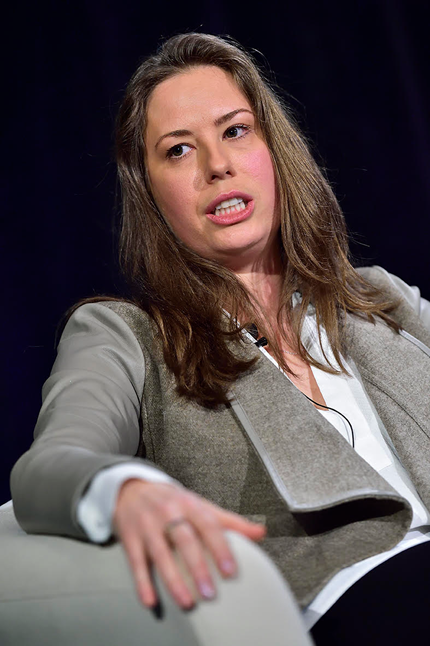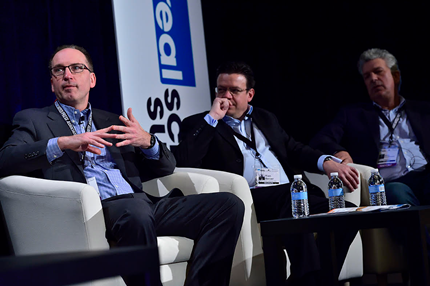4K is for Real, Panel Decides at Real Screen Summit

Words by Carl Mrozek
How soon should producers and distributors of unscripted TV and digital programming begin originating and delivering programs in 4K, and what are some of the big challenges involved, were among the questions posed to a panel of 4K experts at the recent Real Screen Summit in Washington DC. Moderator John Smithson, creative director, at Arrow Media, played the devil’s advocate for cynics “I used to write articles about the 3D renaissance. We thought that we’d all be producing 3D with big budgets, but it just didn’t happen. How do we know that 4K, won’t be more of the same ?” he questioned the panel.
SONY support engineer Mike Des Roches said that unlike with the 3D, the big push for 4K content is coming from the bottom up now, mainly from viewers who have already bought UHD TVs. “SONY and other manufacturers have sold millions of UHD sets in the past few years. Now many of these early adopters are clamoring for UHD content to watch on them,”he said.
This is also true in Europe and Asia, which spurred Television Entertainment Reality Network, TERN, based in Holland, to launch the first UHD satellite channel dedicated mainly to non-fiction factual and entertainment programming. Called Insight, it launched in Fall 2015 with 200 hours of programming and currently reaches most of Europe and much of Russia and Asia. It also plans to enter the US market in the first half of 2016. “We’re filling a vacuum with the highest quality 4K programming, much of which we’re commissioning,” said Rian Bester, broadcast operations advisor for Insight. “We’re pioneering 4K production and transmission via satellite without a roadmap. We’re experimenting with compression schemes to improve storage and transmission efficiency to create the optimum viewing experience,” he said.
Solange Attwood, SVP International for Blue Ant Media asserted that there is currently a serious shortage of 4K programs for the Asian market. “We’re aggregating 4K content for Asian markets now and we’ll supply North American markets once their pipelines open up. There is a substantial demand for 4K programming in Japan and Korea where they’ve had 4K TV for awhile. Germany and France will also have their own 4K channels this year. We’re also negotiating with Rogers Cable in Canada to launch a Canadian 4K channel,” she exclaimed.

Solange Attwood, Blue Ant Media
Attwood was very bullish on the 4K market globally in 'global genres' that travel reasonably well. “This is a time of opportunity for producers and distributors, particularly in niche genres that travel well like: extreme sports, natural history, food, travel, adventure etc. If you’re working in those genres it makes perfect sense to produce in 4K,” she said.
Producer Rasha Drachkovitch, echoed that view. Recently a large cable network asked him to budget for 4K in delivering a program that his company, 44 Blue Productions, was already producing for them.
“For us, shooting in 4K only added around 12% to the budget, so upgrading it to 4K made perfect sense.” Nevertheless, most of their 4K projects are still broadcast, in HD, including one for HBO, wherein they were asked to deliver an HD and 4K master, -the latter for future use.
However, Sara Hume, vp of production mgmt. at Discovery said that some projects they’ve commissioned in 4K have cost considerably more than an extra 12% particularly if for projects using multiple cameras and with high shooting ratios.
Mike Bergeron, business development manager for Panasonic, pointed out that not all 4K content is created equal, in terms of additional data and cost. A key cost factor is the amount of compression used.” Not all 4k is the same. Capturing and storing highly compressed 4K may be no worse than raw HD, while raw 4K is another story,” he said.

Michael Bergeron, Panasonic, Rian Bester, TERN/ Insight 4K, Rasha Drachkovitch, 44 Blue Productions
However one delegate, Alex Halpern,co-owner of the Post Factory, railed that manufacturers and broadcasters are underestimating some of the hidden costs of working in 4K for independent producers “Besides the added capture media & short term storage issues there is the cost of long term storage with redundancy, -particulary with 4K raw as well as with compressed 4K at 60p.. Broadcasters aren’t factoring all of that in when they offer us a little extra for capturing and delivering programs in 4K. They don’t consider all of the new gear we have to buy, and to upgrade as standards and expectations evolve," he said.
Overall, most panelists concurred that it behooves producers of content with a likely shelf life of more than a few years, to capture in 4K whenever possible, in order to upscale their programs to 4K when the demand for a 4K version justifies the cost of doing so. Blue Ant’s Solange asserted that the demand for 4K content will escalate sooner than later. “We’re seeing a huge demand for 4K programs right now which is why we’re expanding our library to 1000+ hours of programs. The demand for 4K programs is going to expand quickly as the number of UHD sets in circulation snowballs and more networks offer it. Netflix, Amazon and other SVOD outlets are now demanding that everything be delivered in 4K. It’s going to explode in the next few years,”” she said.
Photos courtesy of: Rahoul Ghose, RGP.





